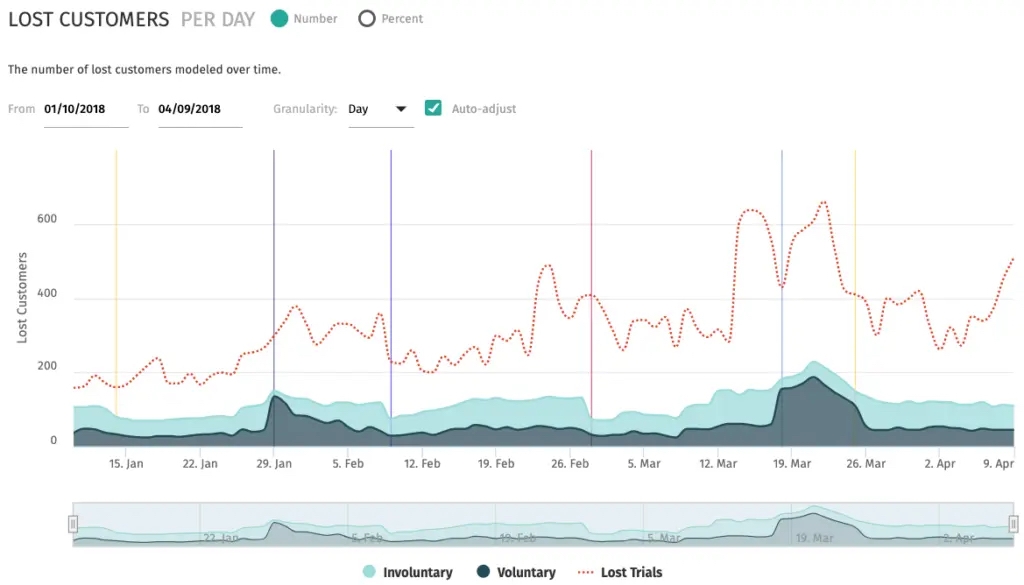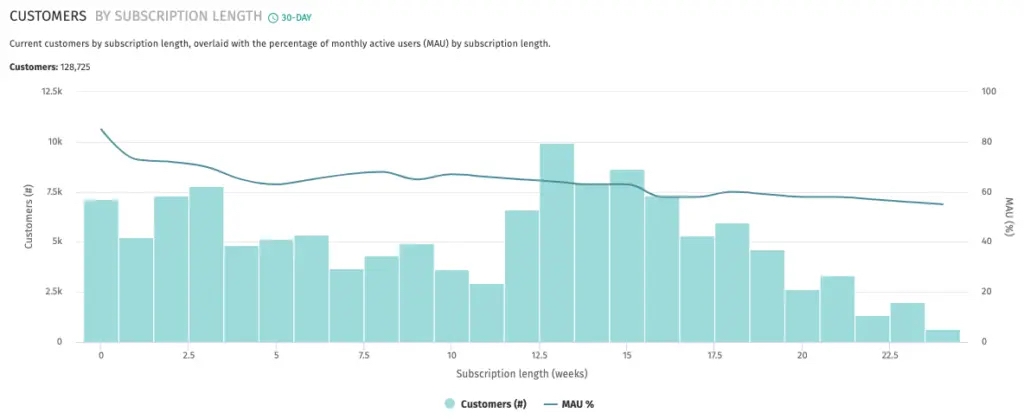OTT churn is a constant battle in the SVOD industry. By Q3 2023, the churn rate for OTT services reached an all-time high of 50%, meaning one in two users left their subscriptions that quarter.
Facing this challenge begins with understanding the reasons subscribers churn, from genuine dissatisfaction to unintended credit card declines. Combating it requires individual strategies that are based on subscriber and engagement data and tailored to the different types of churn.
WHAT IS OTT CHURN?
Churn rate is the percentage of OTT subscribers that cancel their subscription or let it lapse. This is the number of users that left the service in the last 30 days divided by the number of total paid subscribers.
Churn is a primary indicator of the health of your business and how successful you are at retaining your existing customer base. A critical KPI, customer long-term value (LTV), is often calculated by dividing average revenue per user (ARPU) by churn rate.
Brightcove calculates LTV slightly differently by incorporating historical data and applying a retention curve.
Regardless, most businesses spend a lot of money and effort recruiting new customers, so retaining them with a low churn rate is essential to running a successful subscription service.
TYPES OF CHURN
To better manage your OTT churn rate, it’s important to understand how customers leave a service. Typically there are two types of churn:
- Voluntary churn. Customers who intentionally choose to cancel the service. For example, those who binge the entire series that they signed up to watch, then leave.
- Involuntary churn. Customers whose service is canceled due to failed payment methods or natural expirations that are not renewed. Understanding the reason cancellations happen will help you focus retention efforts in the most productive areas. Furthermore, it may also help you avoid payment vehicles or gateways that are less effective at processing payments or retaining customers.
Below is a graph from Brightcove Subscriber Insights that allows you to view the impact of voluntary and involuntary churn and identify trends or anomalies that lead to spikes:
 Fig. 1 – The Lost Customers Per Day Insight shows voluntary and involuntary churn modeled over a period of time.
Fig. 1 – The Lost Customers Per Day Insight shows voluntary and involuntary churn modeled over a period of time.
HOW TO REDUCE VOLUNTARY CHURN
High voluntary churn usually reflects a higher dissatisfaction with the service. Gathering feedback from both active customers and those choosing to leave can help determine the cause of their dissatisfaction.
CANCELLATION REASONS
- Price. An increasing factor for OTT subscribers is cost. Consumers want a good value and SVOD services need a return on their investments. Between changes in sports licensing costs and declines in program production, setting the optimal price point for your service isn’t easy. Keep in mind that the pricing model is more than just your monthly recurring fee. Offering a trial period as well as coupons or promo codes enables you to reward loyal viewers or incentivize viewers who may not renew.
- Content. Having a compelling, regularly refreshed content library is essential. If your library is stagnant, viewers will assume they have seen all the content they might like.
- Experience. If your content is hard to find, your app performs poorly, or your service frequently buffers, users are going to spend less time on your platform. Low engagement times or notable QoE impairments are a good indicator of negative experience and potential churn.
RETENTION TACTICS
Understanding the reasons subscribers cancel allows you to be more targeted in how you message and promote content, ensuring they’re receiving maximum value for the price. It also enables you to be more effective with your save and win-back campaigns.
For example, knowing the videos they watched and their favorite genres allows you to educate them about a new season, a show in the same genre, or a similar class. However, when building campaigns, be sure to look beyond video views per title for opportunities. Dig into how the audience is engaging with the title before including it in your campaign; otherwise, there’s a risk of promoting a video that isn’t holding the audience’s attention.
Coupling OTT churn numbers with engagement metrics allows you to be more predictive and take action to save customers. Brightcove Subscriber Insights allows you to look at data through many dimensions.
For example, you can look at heartbeat metrics (video views per day, audience size per day, etc.) over time and get a view into the engagement of your subscriber base, which will help find indicators of churn. Another way to look at that data is to view the engagement over the lifetime of your subscribers. You can use this metric to monitor the percentage of users coming back on a monthly basis over the history of their subscription. If those percentages go down, you could be headed for a problem and will need to take action to re-engage your base.
 Fig. 2 – Keeping track of weekly and monthly engagement of your subscribers over time is helpful to find indicators of churn.
Fig. 2 – Keeping track of weekly and monthly engagement of your subscribers over time is helpful to find indicators of churn.
HOW TO REDUCE INVOLUNTARY CHURN
Reducing involuntary churn may seem more difficult, but there are some tactics you can employ. For example, there are two categories of payment decline:
- Soft decline. This usually means the credit card is expired or over the limit, the customer is late in paying the bill, etc. Developing retry mechanisms that wait a day or so to reprocess the card may resolve the situation. Furthermore, it allows you to retain those customers with minimal financial risk and without interrupting the customer’s experience. There are even services that can detect prepaid cards and reduce these kinds of failed payments.
- Hard decline. This usually means the credit card is lost or canceled and has very little to no chance of being successfully retried. You are better off employing a dunning process, where you immediately and directly communicate with the customer to let them know of the problem and have them take action to maintain their service.
The type of response should inform your method for retrying a card or re-engaging the customer.
HOW TO PREVENT CHURN
One of the best ways to reduce OTT churn is to identify “at-risk” users and stop churn before it starts. Every subscriber type, even those who have been active for a long time, can swing from “safe” to “at risk” if engagement levels drop. But two particular groups pose a greater risk than others: users who are either idle or inactive.
It goes without saying that these users are already disengaged from your offering. This could be for a number of reasons, and truly understanding subscriber engagement is half the battle when it comes to mitigating the risk of losing them. But knowing what action to take also means knowing what makes these user groups different from the rest.
IDENTIFY IDLE AND INACTIVE USERS
Idle and inactive are two of six subscriber categories based on their engagement status that you can find in Brightcove Subscriber Insights. This means we identify at-risk subscribers based on their account activity rather than relying on metrics such as total number of streaming hours or total views that don’t tell the full story.
- Idle users. Those with no views in the last four weeks but at least one in the prior eight weeks.
- Inactive users. Subscribers with no views in the last 12 weeks but at least one in the last year.
It may be tempting to immediately re-engage both user types and remind them of the value your service brings, but idle users need to be approached very differently to inactive users. Otherwise, you’ll run the risk of triggering the churn event you’re trying to avoid. Instead, you can use data-driven insights to personalize the re-engagement experience and increase the likelihood of winning them over.
RE-ENGAGE IDLE USERS
Idle users have the greatest risk of voluntary churn. One of the most common reasons why they’ve fallen idle is that they’re not seeing enough value from your service. In other words, they may have finished watching the blockbuster content that lured them in but haven’t explored the rest of your content library after that. Or they’ve watched the vast majority of your lead assets and now mistakenly feel they’ve seen everything your service has to offer.
You’ll want to take action fast, so knowing what content will have the desired effect is key. This means polling your content consumption data to understand what other users like them, who have watched the same blockbuster content they have, gravitated to next and what assets held their attention most.
This is easy to do with Brightcove Subscriber Insights. Using insights from Attention Index and Content Explorer, you can accurately identify assets that would help lure idle users back into the fold based on what they’ve watched from your service so far. Also, consider identifying the hidden gems that idle users haven’t seen but would be interested in. This is a powerful way to demonstrate the broader value of your platform.
This data-driven analysis should inform your targeted outbound marketing efforts. From there, approach idle users just like any other marketing campaign. Curate a tailored re-engagement funnel spanning push notifications and email outreach and guide them to content personalized to their interests, pulling them back to the re-engaged category.
It’s also worth considering how frequently you reach out to these users. In our experience, the lifetime value for idle subscribers is 30–50% lower than engaged users. If your standard outreach cadence is every three or four weeks, try increasing your messaging to idle viewers to once a week until they’ve re-engaged fully.
RE-ENGAGE INACTIVE USERS
Inactive users are different. Often, they were drawn to your service for something specific. This may have been an exclusive show or the sports season you had rights to. Either way, the outcome is the same: These users have become inactive but have seemingly forgotten to cancel their subscriptions.
Inactive users tend to have a higher lifetime value than idle users, reflecting their longer tenure with the service. But putting them into a high frequency re-engagement funnel could just as easily remind them about a subscription they didn’t know they still had.
A better way is to treat inactive users as if they’ve already unsubscribed. Don’t just add them to your existing marketing efforts. Instead, run a win-back campaign when new content they’re interested in becomes available (e.g., during the run-up to new episodes of the TV show they binged on or the start of the next sports season).
IDENTIFY AND ENGAGE PRE-RISK USERS
Another highly successful way to prevent churn is to directly engage users before they become inactive or idle. For example, you can use Brightcove Segment Sync to identify users who recently finished a series or season of content or a heavily promoted event. Then, you can immediately reach out to them through email or in-app messaging to promote new content before they lapse.
There are other tactics you can use to reduce and prevent OTT churn, but the most effective ones require a harmonized dataset combining subscription and revenue events with video views and metadata. The story your data tells should be presented clearly where your key actions are evident and easy.




